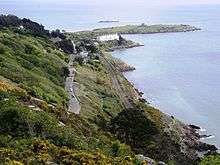Richard MacDonnell (scholar)
| The Reverend Dr Richard MacDonnell | |
|---|---|
 | |
| 29th Provost of Trinity College, Dublin | |
|
In office 1851–1867 | |
| Preceded by | Franc Sadleir |
| Succeeded by | Humphrey Lloyd |
| Personal details | |
| Born |
10 June 1787 High Park, County Cork |
| Died |
24 January 1867 (aged 79) Provost's House, Dublin |
| Spouse(s) | Jane Graves |
| Children |
Sir Richard Graves MacDonnell Major-General Arthur Robert MacDonnell |
Richard MacDonnell LL.D., D.D., S.F.T.C.D. (1787–1867) was the Reformist 29th Provost of Trinity College, Dublin, and the projector of Sorrento Terrace, Dalkey, which is today famous for being the most expensive row of houses in Ireland.
Family
MacDonnel, of the Tynekill MacDonnells of Leinster, was the son of Robert MacDonnell (1764–1821) of High Park, nr Douglas, Co. Cork, and Susanna Nugent (1766–1836) of Ardmore, Co. Waterford, of the Cloncoskraine Nugents in the same county. For the most part of his life, his father had been a prosperous man. He had been given a lucrative revenue appointment at Cork by a close friend of his own father's – George Lowther – and had contemplated an early retirement on his substantial properties. But following the overthrow of Napoleon, property prices fell dramatically and he, like many others, died an impoverished and disappointed man.
In 1810, Richard MacDonnell married Jane Graves, daughter of the Very Rev. Richard Graves, and sister of Robert James Graves. They were the parents of fourteen children, including Sir Richard Graves MacDonnell and Major-General Arthur Robert MacDonnell.[1] He was the uncle of Francis Brinkley and Richard Charles Mayne, and the uncle and guardian of Edmund Allen Meredith, the principal of McGill University in Montreal.
Trinity College, Dublin
Educated at Trinity College, Dublin (1800–1805), elected a scholar in 1803. In 1808 he was elected a lay Fellow at Trinity which allowed him to practise at the Irish bar. He was awarded his LL.D. in 1813 but gave up a legal career in favour of taking holy orders the same year. The remainder of his career was spent at Trinity College, Dublin as a Senior Fellow of the College (1836–1852), Professor of Oratory (1816–1852) and 'an efficient' Bursar (1836–1844), bringing the accounts of the collegiate estates into satisfactory order. In 1852, George Villiers, 4th Earl of Clarendon, Lord-Lieutenant of Ireland, appointed him the 29th Provost of Trinity College, Dublin, succeeding Franc Sadleir and taking up residence at the Provost's House. He held the position for fifteen years until his death in 1867.[2]
He was one of the very few, who from a very early date, advocated Catholic Emancipation, at a time when such views were very unpopular within Trinity. His broad vision and liberal views encompassed both politics and education, far more so than his contemporaries, and the significant changes he brought about are testament to his firmness of character. His period of office is remarkable for the number of new statutes brought in, despite the prejudice he encountered, which almost revolutionised the college code of laws, giving Trinity 'a fresh impetus in its career and usefulness'.[3] Another source described him as 'clever but very lazy'.[4]
MacDonnell was said to have had 'an excellent dry sense of humour', demonstrated on one occasion when showing a lady around the impressive Trinity College Library, Dublin. She, clasping her hands together, exclaimed, 'Oh Mr. Provost, pray Mr. Provost, have you read all these books?', to which he replied, 'in time my dear lady, in time'. On another occasion, after the plates had been cleared between the courses of a dinner he was hosting, his butler quietly placed a sugar cube on his bald head. Engaging his guests on a serious subject, his parrot would by then have flown into the dining room and seated itself on the Provost's head to eat the sugar cube, as the Provost continued with his philosophical musings, giving the impression of being completely unfazed.
Sorrento Terrace, Dalkey

MacDonnell had inherited Knocklyon House near Dalkey, but after his mother died there the previous year, in 1837 he leased it out and bought a plot of land by the sea front at Dalkey, where he built a new country retreat, Sorrento Cottage, now owned by The Edge of the Irish rock band U2. Named after Sorrento on the Bay of Naples, the allure of Sorrento Terrace is its situation and the view across Killiney Bay to the Wicklow Mountains, the Great Sugar Loaf taking the place of Mount Vesuvius.
In the early 1840s, MacDonnell devised a plan for the construction of 22 houses right into the corner near the boundaries of the cottage, a huge undertaking at the time that was stalled almost immediately due to the Irish Potatoe Famine - the family having decided to help those around them rather than themselves. In 1845, the family had built the first and largest of the terrace residences, 'Sorrento House', and then MacDonnell leased the rest of the land to his son, Hercules Henry Graves MacDonnell, who from the 1850s built the remaining houses at a price of £1,000 each. The family stipulated that each house had to adhere strictly to the design of architects Frederick Darley and Nathaniel Montgomery. The houses today are known as 'millionaire's row', famous for being the most expensive row of houses in Ireland.[5]
References
- ↑ A genealogical survey of the peerage of Britain as well as the royal families of Europe
- ↑ Former Provosts of Trinity College, Dublin
- ↑ The Gentleman's Magazine 1857 – Obituary
- ↑ Luce, J V ; Trinity College, Dublin: the first 400 years, p. 99
- ↑ What is it about Sorrento Terrace that has made it Ireland's most sought after address?
| Academic offices | ||
|---|---|---|
| Preceded by Franc Sadleir |
Provost of Trinity College, Dublin 1852–1867 |
Succeeded by Humphrey Lloyd |